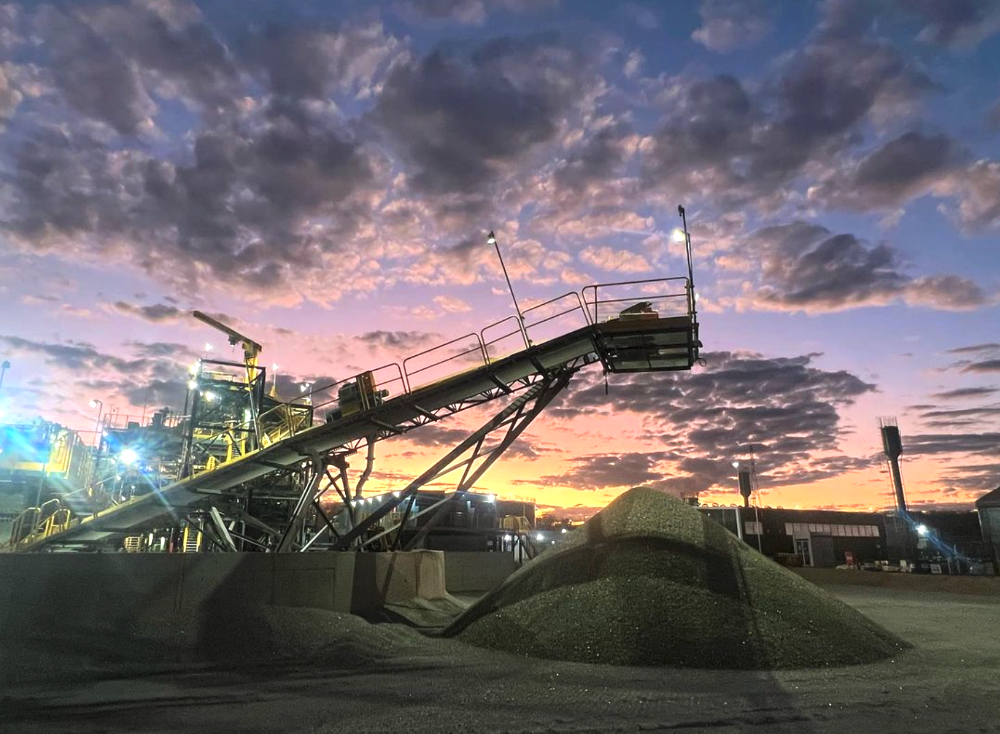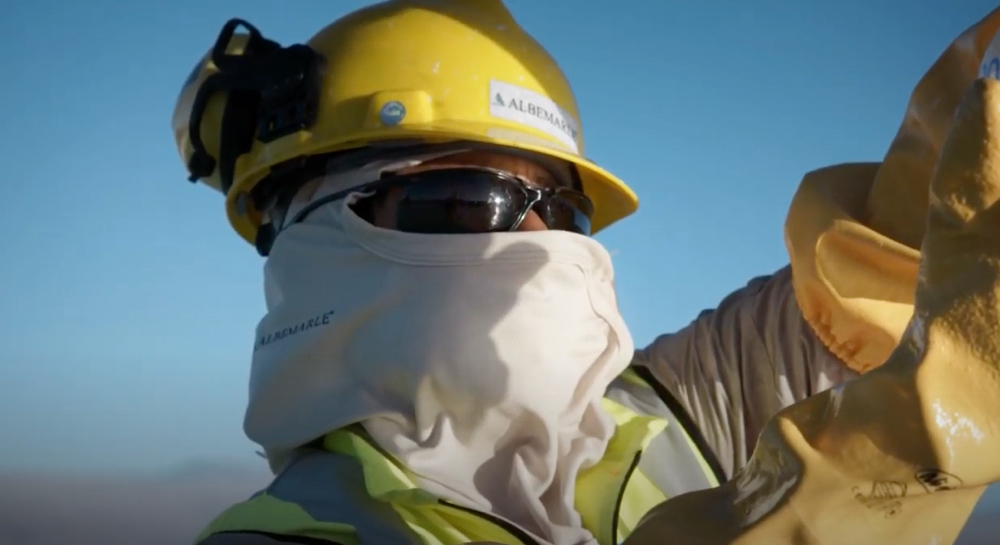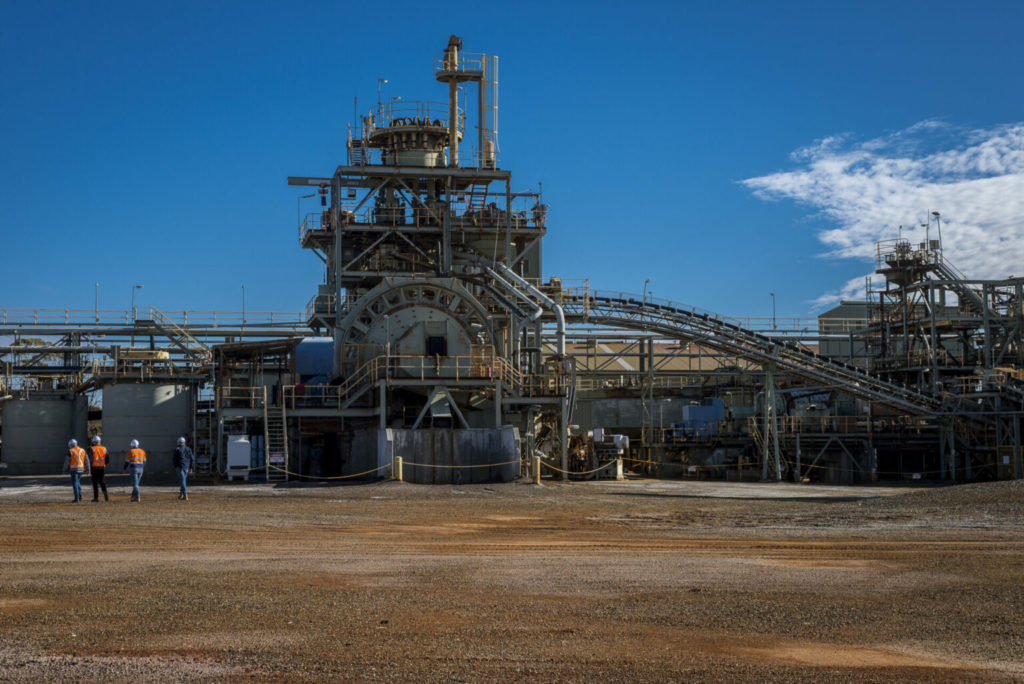Crawfish could transfer ionic lithium from their environment into food chain
IMAGE:
Watch a short Q&A video about this research on YouTube.
view moreCREDIT: AMERICAN CHEMICAL SOCIETY
NEW ORLEANS, March 20, 2024 — From cell phones to watches to electric cars, lithium-ion rechargeable batteries power a plethora of devices. The increased use of this technology means more lithium could find its way into the environment as consumers discard electronic products. Now, researchers describe how lithium can accumulate in a common Southern crustacean: the crawfish. As the season for catching and eating mudbugs comes into full swing, the researchers’ findings highlight the potential implications for public health and the environment.
The researchers will present their results today at the spring meeting of the American Chemical Society (ACS). ACS Spring 2024 is a hybrid meeting being held virtually and in person March 17-21; it features nearly 12,000 presentations on a range of science topics.
“As aquatic organisms, crawfish can take up large amounts of lithium dissolved in water. Because other creatures — including people — eat crawfish, looking at them allows us to see how lithium moves through the food chain, and potentially into us,” says Joseph Kazery, a professor of biology.
Two undergraduate students in Kazery’s lab at Mississippi College, Andrew Doubert and Javian Ervin, are presenting results of their experiments on uptake of ionic lithium by different crawfish organs, as well as the impact of seasonal temperatures. “If crawfish are raised near a landfill or a polluted site, runoff could expose them to lithium, with effects we don’t yet fully understand,” Ervin says. “I myself eat crawfish, so this issue is important to me.”
Lithium contamination is not new. Even before lithium-ion batteries became widespread, lithium was, and still is, used as a medication to treat mood disorders. It enters the water supply in those applications because typical wastewater treatment does not remove drug contaminants. At high levels, lithium can have toxic effects on human health, including potentially damaging heart muscle cells, as well as causing confusion and speech impairment. In other animals, it can cause kidney damage and hypothyroidism. Studies have also shown that when lithium accumulates in plants, it can inhibit their growth, Kazery says.
Although the U.S. Environmental Protection Agency recommends discarding lithium-ion batteries at dedicated collection points, Kazery says they often end up in landfills. Soaring demand along with lax disposal practices suggests lithium is on the verge of becoming a significant environmental contaminant, he says.
As fully aquatic organisms that spend their lives within a relatively small area, crawfish (Procambarus clarkii) reflect local lithium contamination and could serve as powerful bioindicators of its presence in an environment. The lithium they contain could be passed through the food chain to predators, including humans, either directly or indirectly through crawfish-eating fish that people consume.
For its experiments, the team purchased crawfish bred for research. Knowing that the liver collects toxins from the human body for subsequent removal, Doubert wondered whether lithium would accumulate in the crawfish version of this organ: the hepatopancreas. To find out, he added ionic lithium to food for five crawfish, while giving another five lithium-free food. He then examined the amount of lithium present in four of their organs after one week. He found, on average, the most lithium in the gastrointestinal (GI) tract, followed by the gills, the hepatopancreas and, finally, the abdominal muscle in the tail.
The researchers think the GI tract likely contained the highest level because the lithium-spiked food remains there during digestion. Meanwhile, the gills and the hepatopancreas both pick it up while removing it from the body. People predominantly eat the tail, which appears to take up lithium, but not as readily as the other body parts studied.
Doubert also found that 27.5% of the lithium he fed them had passed from the animals’ GI tracts into other tissues. Animals further up the food chain can accumulate higher levels of toxic substances if they eat contaminated prey, so lithium will likely become more concentrated in the predators of crawfish. The researchers expect the high rate of absorption Doubert saw to exacerbate this accumulation in both humans and the other animals that eat crawfish.
Water temperature that crawfish inhabit varies significantly throughout the year. Those shifts affect the animals’ metabolism, even causing them to become inactive during winter. Knowing this, Ervin decided to look at the effects of temperature on lithium uptake. He placed crawfish in tanks kept at temperatures as low as 50 degrees Fahrenheit and as high as 90 degrees Fahrenheit and added a consistent concentration of ionic lithium to the water. After five days, he found that lithium uptake by the abdominal muscle and a part of the crawfish that Doubert did not study — the animals’ exoskeleton — increased in the warmest tank. These results suggest that the animals may contain the most lithium during the warm months, according to Ervin.
The crawfishes’ weight also decreased in warmer water. At this point, it’s not clear how or whether the crawfishes’ weight loss was connected to the lithium they accumulated, Ervin says, noting that the team plans to follow up on these results.
“A lot of people think the use of lithium-ion batteries is a good thing right now, but it is important to explore the effects that may be coming down the road,” Doubert says.
The research was funded by Mississippi College’s Department of Biological Sciences and the Office of Research, Department of Student Research.
Visit the ACS Spring 2024 program to learn more about these presentations, “Absorption of lithium in the various organs of crayfish in a laboratory environment” and “Comparison of methods for determining stress in a crayfish model and environmental application,” and other scientific presentations.
###
The American Chemical Society (ACS) is a nonprofit organization chartered by the U.S. Congress. ACS’ mission is to advance the broader chemistry enterprise and its practitioners for the benefit of Earth and all its people. The Society is a global leader in promoting excellence in science education and providing access to chemistry-related information and research through its multiple research solutions, peer-reviewed journals, scientific conferences, eBooks and weekly news periodical Chemical & Engineering News. ACS journals are among the most cited, most trusted and most read within the scientific literature; however, ACS itself does not conduct chemical research. As a leader in scientific information solutions, its CAS division partners with global innovators to accelerate breakthroughs by curating, connecting and analyzing the world’s scientific knowledge. ACS’ main offices are in Washington, D.C., and Columbus, Ohio.
To automatically receive news releases from the American Chemical Society, contact newsroom@acs.org.
Note to journalists: Please report that this research was presented at a meeting of the American Chemical Society. ACS does not conduct research, but publishes and publicizes peer-reviewed scientific studies.
Follow us: X, formerly Twitter | Facebook | LinkedIn | Instagram
Title
Temperature effects on adsorption of a new pollutant in crayfish
Abstract
Crayfish are an integral part of an ecosystem and could pass on substances to different trophic levels as well reflect thermal changes in the environment by changing body mass and physiological changes in response to changing temperatures. Temperature can affect by crayfishes by influence ion imbalance and alter metabolic pathways. Lithium is found in a trace number of soils, rocks, and in the aquatic environment. Lithium batteries are currently found in phones, car batteries, and watches making them readily available in our environment due to the lack of correct disposal. The purpose of this study is to test lithium adsorption and absorption in crayfish in increasing water temperatures. Live Procambarus clarkii crayfish were placed in four temperature-controlled tanks measuring 10.0, 18.0, 25.0, and 32.0 °C, respectively. Specimens were maintained at a constant pH with a 1 mL/kg solution of lithium carbonate added in each tank. Crawfish biometric data was collected to determine variability of transport of lithium caused by temperature. The exoskeleton and abdomen were separated and digested using acid digestion procedures. These samples were analyzed in an ICP-OES. In this experiment we expect to find increasing concentration in the exoskeleton cuticle due to lithium adsorption in crayfish in respect to temperature.
Title
Absorption of lithium in the various organs of crayfish in a laboratory environment
Abstract
Heavy metals, such as lithium, are an upcoming contaminant. Lithium has many applications in alloys and batteries. With the increased use of lithium-ion batteries, it’s only a matter of time before they find their way into environmental ecosystems. Organisms such as crayfish can be utilized to determine heavy metal contamination because the freshwater crawfish, specifically Procambarus clarkii, accumulates heavy metals from water and sediments in which it lives. Crayfish are known as bottom-dwellers of their aquatic ecosystem and tend to accumulate metals in their tissues, but can also exhibit a high resilience to environmental and metal contamination. The purpose of this study is to determine the percent of absorption and translocation of lithium to various organs, as well as, to determine a hierarchical order of lithium in crayfish organs. Biometric data collected from the specimens was used to determine variations of transported lithium. Male and female Procambrius clarkii were fed 5 mg/kg of lithium-spiked food pellets. After several days, the hepatopancreas, gills, abdominal muscle, and intestines were removed, acid-digested, and then analyzed by an ICP-OES. Results are expected to yield higher concentrations of lithium in the digestive tract, followed by, the hepatopancreas as it is the organ that deals with the absorption and storage of digested food. Levels in the gills and abdominal muscles are expected to be of lower concentration.
Crawfish can accumulate lithium, an environmental contaminant that is expected to increase as battery use grows, and that could affect the people who eat them.
CREDIT
Javian Ervin
CREDIT
American Chemical Society
Rio Tinto to invest $350 million in Argentina lithium project
Reuters | March 19, 2024

At its Rincon project, Rio is developing a small starter battery-grade lithium carbonate plant with capacity of 3,000 tonnes per year. (Image courtesy of Rio Tinto.)
Global miner Rio Tinto will invest $350 million at its Rincon lithium plant in Argentina as it works to begin production by the end of the year, the company said this week following chief executive Jakob Stausholm’s visit to the site.

“The hard work of our Rincon team is laying the groundwork for our first lithium production by year’s end,” he said in a statement to Reuters late on Monday, after a recent trip to the project in the northern province of Salta.
Rio Tinto, the world’s biggest iron ore producer, is one of the few large mining companies betting on lithium even as counterparts such as BHP stay away from investing in the metal, which is used in electric vehicle batteries.
The company purchased the Rincon project from Rincon Mining in 2022 for $825 million, and plans to develop a battery-grade lithium carbonate plant with an annual capacity of 3,000 tons.
Rio Tinto said it is working with local communities and authorities to ensure environmental standards.
Argentina, part of a so-called “lithium triangle” with Chile and Bolivia which holds half the world’s resources of the mineral, has increasingly attracted investment from international lithium miners.
The country’s lithium production increased more than 45% from 2022 to 2023, according to the US Geological Survey, reaching 9,600 metric tons.
(By Lucila Sigal; Editing by Daina Beth Solomon and Alistair Bell)
Reuters | March 19, 2024 |

Sigma Lithium reports an expected annualized production of 270,000 tonnes Li2O this year. Credit: Sigma Lithium
Sigma Lithium said on Tuesday its unit received an initiation letter of arbitration from South Korean company LG Energy Solution.

In its request for arbitration, LG Energy alleges that Sigma Lithium is in breach of certain provisions in connection to a lithium supply agreement entered in 2021.
“The claims are completely without merit and intends to defend its interests vigorously,” Sigma said in a statement.
US-listed shares of Sigma were down 1.6% at $12.35 in extended trade.
In 2021, Sigma and LG Energy had entered into a six-year offtake agreement for battery grade sustainable lithium concentrate scales from 60,000 tons per year in 2023 to 100,000 tons per year from 2024 to 2027.
(By Kabir Dweit and Arunima Kumar; Editing by Alan Barona)
Reuters | March 19, 2024 |

Image: Albemarle
Albemarle, the world’s largest producer of lithium, has announced it will conduct a series of auctions for its products on the Metalshub digital trading platform.

The first “bidding event” will be for 10,000 metric tons of spodumene ore and is scheduled for March 26.
The aim, according to Albemarle’s notice to customers, is to “explore price discovery while ensuring a fair and transparent process for all customers”.
The key word in that sentence is “transparent”. The entire lithium supply chain has been rocked by the collapse in prices over the last year.
But just how reliable an indicator are those prices? Albemarle’s decision to conduct a series of online auctions suggests it thinks the lithium industry could do better.
Fractured pricing
The explosive growth of the electric vehicle battery market has transformed lithium from a specialty niche product to mainstream industrial material in the space of just 10 years or so.
Lithium pricing hasn’t yet evolved to match the scale of that transformation.
Albemarle, like most established producers, has historically sold most of its lithium on fixed-term contracts directly negotiated with buyers.
That, however, only partly insulates it from the volatile spot price, which is primarily determined in China, the world’s largest converter of lithium raw materials into battery-grade material.
China’s first futures price came in the form of the Wuxi Stainless Steel Exchange, which launched a lithium carbonate contract in July 2021.
Wuxi immediately had an outsize influence on global pricing, although it was a problematic benchmark, based on spot physical trading of non-battery grade carbonate among a limited number of Chinese players. The relationship between Wuxi futures pricing and lithium reality was at best unclear.
Wuxi’s influence on Chinese and international prices has waned after the July 2023 launch of a lithium carbonate contract by the Guangzhou Futures Exchange (GFEX).
GFEX, though, has turned out to be just as wild a price indicator as Wuxi. A wave of speculative enthusiasm saw volumes on the new contract almost double between October and November with the exchange forced to hike margins, opens new tab and expand trading limits to cope with the volatility.
That hasn’t stopped GFEX from rapidly becoming the accepted reference point for lithium pricing, even though non-Chinese entities will struggle to access it.
Western companies looking for price management tools are currently limited to the CME’s lithium hydroxide contract, which has built up impressive momentum but remains small relative to its Chinese peer. CME open interest at the end of February was 22,275 metric tons, compared with 321,329 on the GFEX.
The London Metal Exchange’s lithium contract has failed to trade at all, while that listed with the Singapore Exchange traded just 18 lots last year and has notched up volumes of only 30 lots so far this year.
All Western futures contracts are settled against price assessments from Fastmarkets, which like fellow price reporting agency Benchmark Mineral Intelligence publishes an array of assessments intended to capture the complexity of the lithium supply chain.
A third way?
It’s not difficult to see why Albemarle is looking to find a third way between the wild eastern Chinese carbonate market and a Western hydroxide futures offering which rests on third-party price assessments.
Ironically, the only other hard pricing reference point looks set to disappear.
Pilbara Minerals has held regular auctions for its spodumene via the Battery Metals Exchange, generating a degree of price transparency at the upstream end of the production chain.
However, Australia’s largest independent miner has said it now has little uncommitted material left to sell, meaning future spot sales are “unlikely”.
Albemarle’s spodumene auction later this month will help fill the pricing gap, but it seems highly likely that more tenders of lithium in other forms will follow.
If there are enough of them, it may be possible for Metalshub to generate a price index based on the physical peer-to-peer transactions on its site.
Metalshub has built its trading platform around steel alloys such as manganese and chrome.
As with lithium, such metals tend not to come in standardised form and have historically not been exchange-traded but rather assessed by the likes of Fastmarkets.
Metalshub has changed that dynamic and is now working with the LME to open up a forum for the trading of low-carbon nickel with the ultimate goal of producing a transaction-based “green” nickel index, opens new tab to complement the LME’s standard Class I contract.
Such digitalization of markets “is becoming more relevant and Albemarle supports this development”, the company said in its alert to customers about the upcoming “bidding event”.
Desperately seeking stability
Global lithium mine production has mushroomed from 25,000 tons in 2010 to 180,000 tons last year, according to the United States Geological Survey.
The world needs a lot more of the stuff if it’s going to move away from the internal combustion engine to reduce global emissions.
But producers’ ability to finance and build new capacity has been undermined by a boom-bust pricing loop, with last year’s collapse being the latest downturn of the cycle.
To some extent this reflects the problems of aligning production with demand in a fast-evolving market. But the lack of a transparent benchmark price and limited ability to hedge price risk is not helping.
The lithium supply chain is maturing but the metal’s pricing seems trapped at the early development stage.
Albemarle should be credited for trying to change that problematic price paradox.
(The opinions expressed here are those of the author, Andy Home, a columnist for Reuters.)
(Editing by Paul Simao)
Reuters | March 17, 2024

Lake Johnston primary mill. Credit: Poseidon Nickel
Australia’s Mineral Resources said on Monday it intends to develop a lithium processing hub in the Goldfields region of Western Australia after its buyout of Poseidon Nickel’s Lake Johnston nickel concentrator plant and mining rights.

Billionaire Chris Ellison who leads the diversified miner has been vocal about his plans to centrally process lithium ore mined in the region from third parties and from miners it has a stake in, in a “hub and spoke” model.
Australia ships out around half of the world’s supply of the battery raw material and the move is another step in the magnate’s plan to dominate the lithium sector where it already owns three hard rock mines.
“We intend to bring our expertise in spodumene production to Lake Johnston, which has the potential to service projects throughout the world’s most prospective region for lithium,” Ellison said in a statement.
MinRes will convert the existing nickel plant to be able process the lithium into spodumene concentrate. It has not disclosed the capital costs of the project.
Ellison has said that further processing in Australia such as the battery grade lithium hydroxide that Tianqi and Albemarle make was too expensive in current conditions.
It will pay A$1 million ($655,900) on execution of the acquisition agreement, A$6.5 million on completion of the deal and a further A$7.5 million, a year after the completion.
The move comes as the Australian government considers a tax credit for companies that build processing facilities to boost the value of green energy minerals and as nickel miners have put projects on ice due to low prices.
“He’ll either buy (spodumene) at the mine gate or toll it through the plant.. There will obviously be a number of different arrangements he can do with the juniors,” said analyst Glyn Lawcock of Barrenyjoey in Sydney.
Ellison will be able to “clip the ticket” several times, by charging for opportunities such as mining, crushing and transportation, Lawcock added.
Without a processing hub for third-party ores, much of the region’s material would not be viable to process, Ellison has said.
MinRes has stakes in developers in the region including Global Lithium and Delta Lithium. But it lost out in its bid to buy Azure Minerals, which has a flagship project in the Pilbara region, to fellow billionaire Gina Rinehart and Chile’s SQM late last year.
($1 = 1.5246 Australian dollars)
(By Melanie Burton and Ayushman Ojha; Editing by Chris Reese and Jamie Freed)

 Dr. Arthur L. Diskin is a graduate of the University of Miami School of Medicine with specialty training in Emergency Medicine and an interest in critical care. He is certified by the American Board of Emergency Medicine and is a Fellow of the American College of Emergency Physicians. He has held leadership roles such as the Past President of the Florida College of Emergency Physicians and is the former Chief of the Department of Emergency Medicine at Jackson Memorial Hospital in Miami, Florida, and Mount Sinai Medical Center in Miami Beach, Florida.
Dr. Arthur L. Diskin is a graduate of the University of Miami School of Medicine with specialty training in Emergency Medicine and an interest in critical care. He is certified by the American Board of Emergency Medicine and is a Fellow of the American College of Emergency Physicians. He has held leadership roles such as the Past President of the Florida College of Emergency Physicians and is the former Chief of the Department of Emergency Medicine at Jackson Memorial Hospital in Miami, Florida, and Mount Sinai Medical Center in Miami Beach, Florida.